Fujifilm Q&A @ CP+ 2017: Fuji GFX insights, 4K video, future lens plans & instant film’s surprising comeback
posted Tuesday, February 28, 2017 at 6:00 AM EST

During the ongoing CP+ 2017 tradeshow in Yokohama, Japan, Imaging Resource founder and publisher Dave Etchells sat down with Shinichiro “Shiri” Udono and Makoto Oishi of Fujifilm Corp. Udono-san is Fuji's Senior Manager in the Sales and Marketing Group, Optical Device and Electronic Imaging Products Division, and Oishi-san is a Manager in the same group. Readers may recall that Dave interviewed Oishi-san at CP+ 2016 as well.
The first topic discussed was Fuji’s mirrorless foray into medium-format digital photography, the Fuji GFX, which we recently got our hands on for some real-world shooting. After discussing the GFX and GF lenses, Dave asked Udono-san and Oishi-san about Fuji’s famous Film Simulations. If you were wondering how they’re developed, you will find some excellent information on that topic in the interview below.
Mirrorless is obviously critical for Fujifilm, both in terms of the established X-series of cameras and the new GFX. You might have heard the news earlier this week that Fujifilm is releasing a pair of cinema lenses for Sony E-mount before their own mount, which is very interesting, especially given the company’s recent inclusion of 4K video in the X-T2 -- and you'll find the reason for the Sony-first strategy revealed in the interview. On the topic of 4K video, meanwhile, Dave also confirmed why the Fuji X-Pro2 -- despite using the same sensor and image processor as the X-T2 -- cannot shoot 4K UHD video.
Additional topics include the X100 series' surprise success and the user base of Fujifilm’s popular Instax line of instant cameras and film. To get the full scoop from Fujifilm, read on!
Dave Etchells/Imaging Resource: How is the demand is for the Fujifilm GFX 50S? It's been announced and it's starting to ship: Is the demand very high?
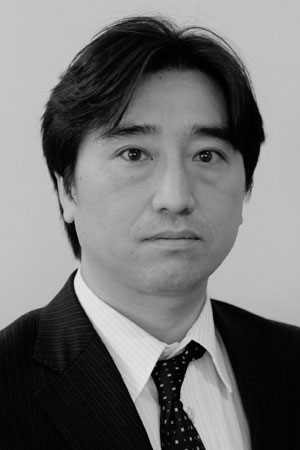
Senior Manager
Sales & Marketing Group
Optical Device & Electronic Imaging Products Div.
Fujifilm Corp.
Shinichiro 'Shin' Udono/Fujifilm Corp.: Yes, actually it's higher than we expected. Since we announced in Photokina 2016, we knew a lot of photographers [were anticipating] the power of the larger-sized sensor. When we announced the price last month, [our] photo retailer partners have [received] a lot of questions or contacts from their customers.
William Brawley/Imaging Resource: Oh, okay.
SU: Actually, the total number of orders was much higher than we expected.
DE: It was much higher than you expected, and it's coming through photo retailers? They are making big orders because they have a lot of interest from their customers?
SU: Yes.
WB: That sounds like a good problem to have!
SU: Yeah, it is. Especially the professional camera retailer or professional distributor, the main dealer taking care of the professional photographers for their equipment. Before [with] the X-series, of course we were selling [to pros as well], but this time it's [predominantly] the professional channel.
DE: It's the professional channel more.
WB: So you're seeing a lot of response from the existing professional photographers that maybe changing systems to this now.
SU: Yes, we think so.
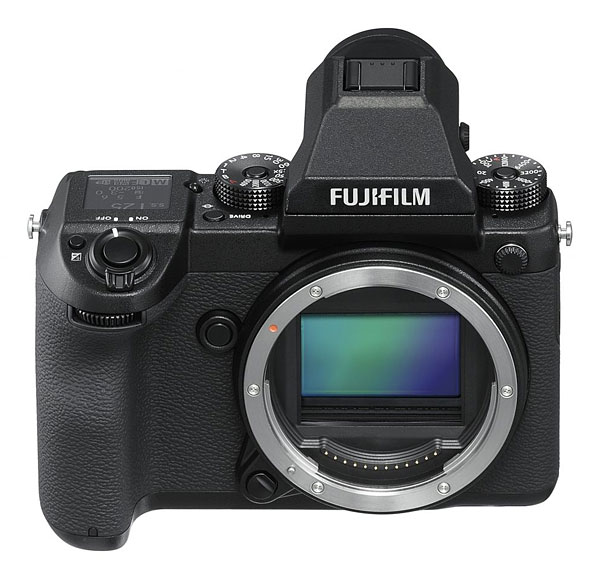
DE: Ah, very interesting. Some people have been saying that the slower X-sync would be an issue for professionals, that they wanted a higher flash sync speed. But it seems like while some do want that, that you haven't seen any limitations in sales, that actually many more are buying it than expected. And you have three lenses launching with the GFX. Are you also seeing a high attach rate, that people are buying the body and lenses too?
SU: Yeah, yeah, we think so. Because at this moment we have only three lenses, it seems that customers choose this 63mm [prime] or this [32-64mm] zoom lens.
DE: So the 63mm prime or the 32-64mm zoom are the two most popular...
SU: Yeah, so [the 63mm prime is] a fast lens and maybe 30 to 40 percent customers [prioritize] this [and buy] the [120mm] macro lens on top of the standard lens.
DE: Yeah, yeah.
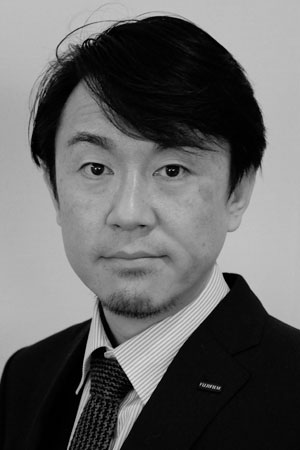
Manager
Sales & Marketing Group
Optical Device & Electronic Imaging Products Div.
Fujifilm Corp.
Makoto Oishi/Fujifilm Corp.: The demand of the zoom lens is a bit higher than expected.
SU: Yeah, higher, maybe because of the angle...
WB: Yeah, wide angle and a big sensor [makes sense for] landscape photographers probably.
DE: Yeah, yeah.
SU: Makes sense, yes.
DE: Boy, that's encouraging to hear. We were certainly very impressed with the announcement when we were briefed in Photokina and saw what you had coming. At the time, you said that you are actually designing the lenses to a resolution standard to match 100-megapixel for when the next generation sensors come out, so they'll be very, very sharp too. Well that's great. That's interesting that you're seeing such high demand.
And so you have the three lenses shipping with the camera, and you have announced a total of six lenses. Can you share anything more about your roadmap for lenses, looking into the future? We're wondering are there longer lenses coming, because the longest one which has been announced is the 120mm which is not very long for the medium format. So can you say anything about what your roadmap is, past the six lenses you've announced so far?
SU: Actually we didn't confirm yet, but now we are [assessing] the demand. We already have some requests about the next lens, especially for maybe a telephoto prime around 200mm focal length. Or maybe a wide zoom, like a 15mm, a more ultra-super-wide zoom.
DE: Wow, 15mm on that large a sensor...
WB: Almost like your 10-24mm but for that size sensor.
MO: Yeah, that's one of the requests, yeah.
SU: And also, maybe everybody want to use a tilt-shift lens for architecture...
DE: Yeah, I could see architecture being a big application area. Boy, tilt-shift for that large format would be difficult because you already have such a large image circle, and then to make it be able to tilt/shift...
SU: And one other zoom, because [the 32-64mm lens is equivalent to] a 25-50mm one [on a 35mm camera], right? So maybe a 70-200mm or something like that, [to offer] more [versatility].
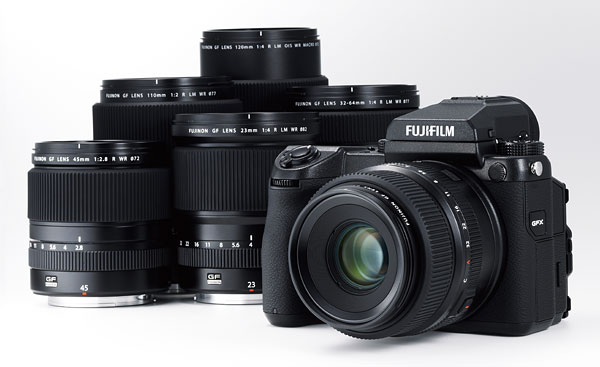
DE: Yeah. So those are the areas you're seeing the demand: A long prime, maybe a super-wide zoom, a longer zoom and the tilt-shift.
SU: And the mid-tele zoom.
DE: And so it's like the customers are voting now, and you're counting the votes?
SU: <laughs> Yeah.
DE: So it's interesting, some people have commented that [they feel that] the natural competitors for the GFX are full-frame cameras like the Canon 5DS R, more so than the Phase One or Hasselblad. Do you feel that's true? What are the people buying these coming from, do you think?
MO: So the current, the situation is we have I'd say a 50/50 [split] of the customers that we are catching, at the moment. One side is the professional photographers, studio and fashion photographers [and also] the commercial photographers and landscape photographers. So that's the main customer [base]. But also the photo retailers are giving us a lot of orders, so we think [that] means especially the enthusiast customers [who are] expecting higher resolution and wider dynamic range [are also considering the GFX]. So that kind of the customer, we think they are probably landscape shooters.
DE: And so you think the 50/50 split is between professionals and high-end amateurs?
MO: Yes, yes, that's our current feeling.
DE: And do you think they are people who have been using full-frame, or have been using medium format like a Hasselblad or Phase One already?
MO: Yeah, of course we are catching the medium format customers, but also we have also lot of contact from full-frame [customers]...
DE: A lot of people are moving up, so it's a mix there also.
MO: Yeah, yes.
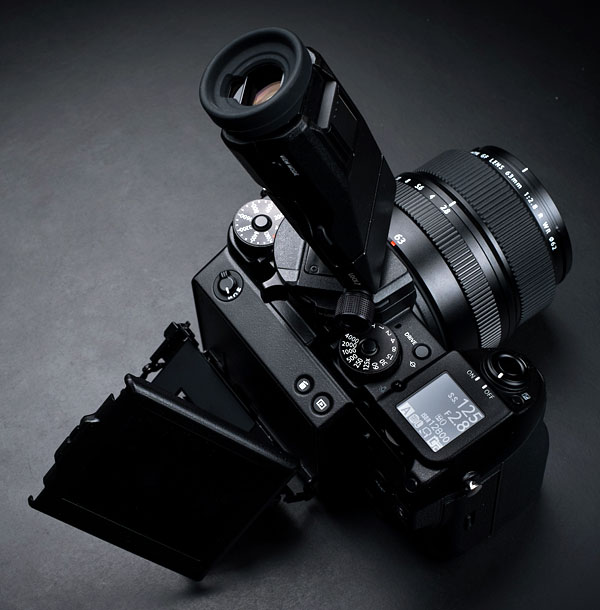
DE: This is a completely different question: The Film Simulation mode seems like a very big feature for Fujifilm cameras.
SU: Yep.
DE: It's one I feel isn't as well-appreciated or understood as it might be. I think that it would sell even more Fujifilm cameras if more people understood it. We all have personal favorites. I like the Acros simulation very much. It reminds me of when I used to have a darkroom, and had black and white film, and that [mode] reminds me of the film very much. You have a lot of film simulations now, so where do you go from here? Can you give us any hints at what you're looking at? Have there been requests from users for specific types of film simulation?
SU: Actually we already spent more than 10 or 15 years developing the film simulations for digital.
DE: Wow! 10-15 years developing it.
SU: Yes, because we just started from the FinePix S3 Pro, it was the first one [to offer] Provia, Velvia and Astia [simulations]. And after that we developed others like Acros, [for] the films which we used to [manufacture]. But only the Classic Chrome is not [a film stock] from Fujifilm, right?
DE: Yeah.
SU: But so many users still have a demand [for] the old films, like maybe 60s or 70s.
DE: Yes, emulsions from other manufacturers.
SU: Yeah. Some [want] maybe AGFA or Kodak, or...
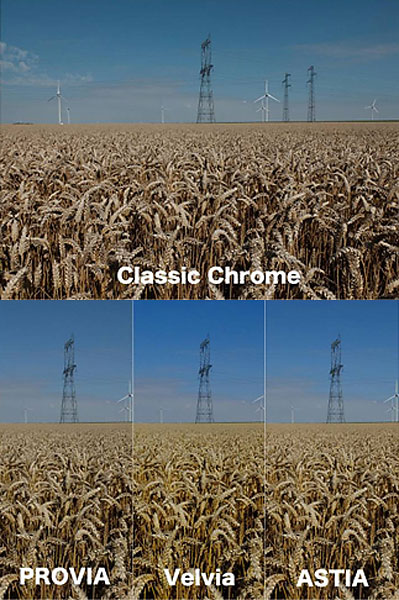
DE: So you're getting requests from people for other non-Fuji emulsions?
SU: I think it's the same as film, because [the reason] why we developed so many films was the demand from customers, right?
DE: People have different preferences and tastes, yeah.
SU: Yeah. And it is totally the same, even [though] the "films" are now digital. So now we are [investigating what's next]. But some films need new technology, right? Like Acros is only [available] from the X-Pro2 and later.
DE: And that's because it required so much processing to do it?
SU: Yes.
DE: I would think that just the tonal adjustment is not so difficult. Is some of that [performance requirement] because of simulating the grain, maybe?
SU: Yeah, grain is quite [an important] quality we want to [recreate].
DE: That's very interesting. [The Acros simulation] is so beautiful, it really reminds me of my darkroom days. And it's kind of neat: With analog film it was very difficult to manufacture a different emulsion. Now in the digital era, it's [still] difficult to figure out the programming for a simulation, but it's not like you have to create a whole new production line for each new film type. So that's pretty cool.
I don't know how much you can say, but we're curious about how you actually go about creating a film simulation? Is it just a matter of you very carefully measuring each emulsion's spectral response and tone curve, and then mapping that into RGB? Or is there more of an art involved; is it something that you have to create [a simulation], look at visually, and then decide [if it's right]? And also, does the tone curve or color response vary with brightness or something, so it's more complicated than just...
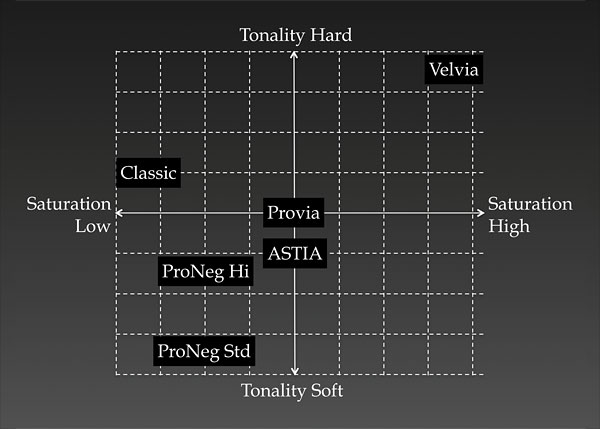
SU: Of course it's a digital system, right? So it's totally different from the analog side, but yeah, actually more than 15 years ago we measured the film's color and tonality physically...
DE: Yeah, yeah...
SU: And then Fujifilm's color reproduction and tonal reproduction is totally the same technology [applied] by some matrix, right? And we have a special software for optimizing [it], making it more to our target color space, color tones, and so on. That is our unique technology.
DE: So you have special analysis software that does the color management, and so basically that's where the special technology comes in is that you have figured out how to go from just careful measurements of the emulsion into mapping it into the color space of the camera?
SU: Because you know, films and digital sensors [have a] totally different spectrum.
DE: Yeah, and the film dyes are going to have different color profiles and then here you've got the RGB sensors, so it's tricky to map it. But it sounds like it is pretty much a mathematical process that you just measure and then the software can confirm.
SU: Yeah.
DE: So it seems like you have actually been doing quite well in the mirrorless market. Back at CP+ 2016, Toshi had mentioned that Fujifilm's global market share for mirrorless was 14 to 15 percent. Has that changed since? Because I know that the market is changing, Sony is very aggressive...
MO: [In] 2016, we launched X-Pro2 first, and then in the autumn time, we launched the X-T2. Actually our share now, I think, we average very close to 20 percent, I'd say.
DE: Wow, 20 percent in mirrorless. And like I said, that's with stiff competition too; Sony has been extremely aggressive.
MO: Yeah.
DE: But you're actually gaining market share in mirrorless, wow. Well congratulations, that's great! So the X-Pro2 and X-T20 actually used the same sensor, the X-Trans CMOS III...
SU: Yes.
DE: ...and the X-T20 can shoot 4K video, but the X-Pro2 stops at Full HD. Is 4K something that could be added to the X-Pro2 via firmware, or is it that it's a different processor so it couldn't handle it?
SU: Basically, we cannot upgrade the X-Pro2 because it's a difference of hardware.
DE: Ah, so it's different hardware. So the X-T20 has a more powerful processor or a different architecture...
SU: And power consumption, maybe something like a heating solution...
WB: Because the X-Pro2 still uses the X Processor Pro, which is the same processor as the X-T2 and X-T20...
SU: Yes, [it's the] same processor, same sensor. But, you know, so many other parts [differ].
DE: The physical design, yeah.
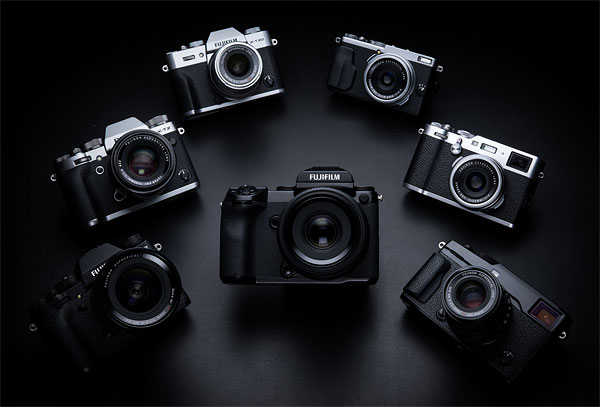
MO: Other components and the camera design itself are very different.
DE: Heat sinking and that sort of thing?
MO: Yeah.
SU: And the X-T20, we based on the X-T2, which has 4K movie, but then we downsized it.
WB: Yeah, it's a small version of that, right.
SU: It is.
DE: Back to a question about lenses and the X-mount lens roadmap. The last time we saw an updated roadmap was the summer of last year. The XF50mmF2 R WR was announced last month. Is that still on track to be available this month, or when will that start shipping, do you know?
SU: The 50mm f/2 is this month, yes.
MO: Yes, it's coming.
DE: And how about the XF80mmF2.8 R LM OIS WR Macro. That has been announced and is coming, do you know timeframe when that will ship?
SU: This year...
MO: Late this year.
DE: And you had an XF120mmF2.8 R OIS WR Macro that was cancelled in favor of the 80mm. What led to that decision?
SU: Quality, size and autofocus speed [were the reasons]. And we also have a 1.4x teleconverter, so [that] combination allows it [to] make it like 120mm...
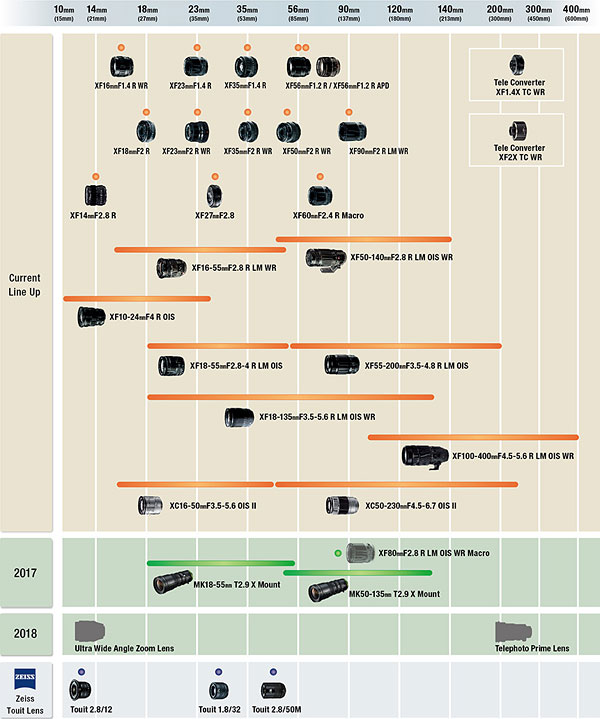
WB: Ah, so that one is compatible with [the teleconverter]?
SU: Yeah, hopefully. We're still developing [it] but hope we should [be able to] do that.
DE: But you feel that the 80mm design, you were going to be able to achieve just much better performance, resolution and speed, etc.
SU: [A better] balance, yeah.
DE: Are there any additional lenses planned for 2017 in the X line?
MO: Did you see our latest lens roadmap?
WB: Yeah, downstairs. It was just announced this morning that new lenses were coming out, but for 2017 there aren't any new ones.
DE: Ah, yeah. Okay.
DE: [There's an] 18-55mm [and a 50-135mm]...
WB: Those are the cinema lenses.
DE: Yes, and then the 80mm is coming [in 2017 also]. And then out in 2018 is an ultra-wide angle zoom and a telephoto prime. Ah. Yes.
WB: So I see that you're offering both E-mount and then later X-mount [variants] of the new cine lenses. Can you describe the decision to support E-mount in the first place, and why [it's] first before the X-mount?
MO: Okay, so Fuji, started cinema lens business many [years ago with our] Fujinon [brand]...
WB: Yeah, you've made Fuji lenses for cinema [for] a long time.
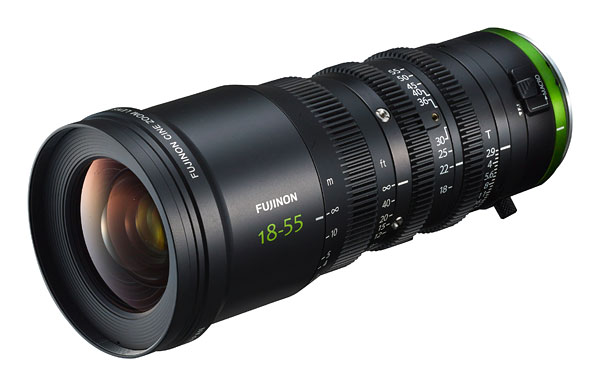
MO: Yeah, and currently we had top-range cinema lenses with a PL-mount, so [those lenses were] already in our lineup. So [at] this time, especially in the videographer's market, there are a lot of videographers [who] have to shoot movies for web content. So they need a smaller, lighter package for the movie system. For example, Sony: Not the Alpha 7 [series], but the FS7 and FS5. So that is quite common sort of camera in the movie shooting category.
DE: A compact, interchangeable-lens camcorder.
WB: Right.
MO: So our target is [videographers] using the Sony FS5 and FS7, yeah.
DE: So that's kind of in line with your existing long-term cine lens business, and that's an area in the market where there's particular demand.
MO: Yeah, yes. And especially after we launched the X-T2, that has 4K function [and] there has been a lot of videographers [who] really loved our movie image quality, so actually we got a lot of requests from videographers [that] Fuji shooters should have more video-capable functionalities of the cameras...
WB: Right.
MO: ...because they know also the Fujinon lens quality. So then we came up with the cine for the Fuji mirrorless cameras [too].
DE: And it sounds like you've been getting a lot of requests for more video features on your X-series, and so you're working now to advance that?
MO: Yes.
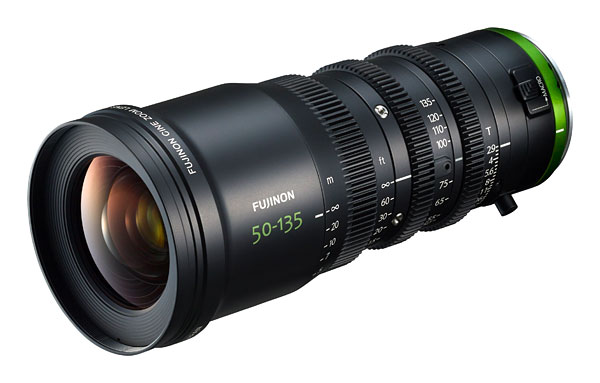
SU: Especially after launching the X-T2, [which has a very capable] movie mode, right? So after that, [we received] so many requests [for] more.
WB: Are there lots of requests that [could] potentially [be] added on via firmware, or [is it more] like "OK, the hardware just can't do it, we have to wait until..."
MO: Some requests, of course, are included in the firmware. And some, are of course hardware.
DE: It was interesting when you started with the X-series that you had a very specific focus that I think worked very well for you, which was that you were going to come out with very high-quality optics and the X-Trans sensor, which produced very high-quality images. You weren't trying to start with a cheap camera and work your way up [as some rivals did]. You started very premium, and you also had a very strong focus on still photographers. And now you've got that market very solidly and your technology has evolved, and so now you're moving into video as well.
MO: Yes, yes. This year, we have a special movie corner in our booth.
DE: So we're interested [by the fact that] the X100-series cameras have been very popular on our site. William has an X100T with him there, and Dave, our Managing Editor, always has an X100S.
WB: Yeah, that's like his go-to camera.
DE: And so, they're very popular. But they also seem like a very niche camera, in many ways. Are you surprised by how well-received they have been, considering that it's sort of a specialty product? And how do you view them in your product line overall?
MO: So it was six years ago when we launched the X100. Actually, we were surprised because [we received a] big demand.
DE: Really, yeah.

MO: I think the first version we [sold] more than 100,000 [units].
SU: Yeah, much more...
DE: Really? Much more than 100,000 units?
MO: Yeah. So then after that, [we followed up with the] X100S and the X100T, so similar models, and then maybe some part -- 20, 30, 40% -- of the customers, they keep [upgrading]. And also we are catching 60-70% of new customers every time.
DE: Wow.
MO: I think that probably in the first stage, it was mainly the Fuji [fans] just buying the X100. But [with] the second and third generation gradually we are catching even the SLR sort of customers, because they are using this as a second camera.
DE: Ah.
MO: I think the people who are shooting with larger sensors, so SLR or mirrorless, whatever, they don't want to compromise even [with] their daily [shooter]...
WB: They want small, [but] they don't want to go so small that it impacts image quality.
MO: Yeah, so that's the reason. I think that the [key] point is the APS-C image sensor, so no compromise on the image quality. So that is attracting that sort of customer looking for the best sub-frame camera.
DE: So it's really a major product for you then. That whole product line has been very high volume.
SU: [Yes, and] the biggest market for the X100 is the USA.
DE: Really? Interesting!
SU: Yes.

DE: Huh. I wonder what it is that particularly captures U.S. sensibilities. I know Dave just loves it, that's just what he has [with him] all the time.
WB: Yeah.
DE: That's very interesting. We have a reader question about the X100F; it's a bit of a long question. He would like to know whether the back-button focusing provides an option for disabling focus from the shutter and activating focus from the AF button, or being able to focus with the rear AF button in manual, but with a variable size for the bright-frame overlay. He doesn't like the setup on the X100S.
MO: Yes, [for] the X100F we changed [it to have the] same [AF button] functionality of the X-T series. For the green [bright-frame overlay] rectangle, or the parallax compensation, that was originally improved for the X-Pro2 and then we [have shared] the functionality with the X100F.
DE: Ah, okay, so it was improved on the X-Pro2 and now the X100F has it, whereas the X100S did not. Good. We didn't have such a large number of questions this time...
<laughter>
DE: ...maybe that's good. <laughs> So a completely different direction: Instax instant film and cameras are seeming to be very popular. But who is the typical customer for that? I'm thinking it's youth more? Do you see big differences in the popularity and the kinds of customers that are buying that in different regions?
WB: Even in the U.S., I think the past couple years it was the most popular photography item on Amazon in the holiday season.
DE: Yeah, which is kind of crazy.
MO: I think that the last two years [in the] Christmas season, that the Instax sales of both camera and film are quite good.
DE: Yeah.

MO: And who is the customer? So what we learned is that [it's] actually very young customers who don't have [experience of using film]. [For] young people, it is quite a new technology [to them]. The print is coming up from the camera; that's a big surprise for the young audience and they really like it.
DE: Yeah.
MO: And so then it's a nice gift for Christmas, and also [good for the Christmas] party scene, so they bring the Instax camera.
DE: That's so funny.
WB: So in a party situation, you can share a digital photo, you can put it on Facebook or something. But for instant film, it's like, well who gets [to keep] it?
MO: The funny thing is that they get the print, [then] they take the photo of the print and upload it to Instagram. It's quite funny!
<laughter>
MO: Actually we didn't expect such a usage of the camera.
WB: Ah, interesting.
SU: [It's a] totally new generation. No one knows about Polaroid and so forth.
DE: That is *really* funny! Yeah, they've never seen Polaroid and so the idea that "Wow, the camera spits out a photo, it's so cool!" [has great appeal]. And then they take a picture of the print.
MO: Some young people [tell] us "What a new technology, this is very original technology!" <laughing>
DE: Wow, that's really interesting. Well it's good that it keeps film alive that way.
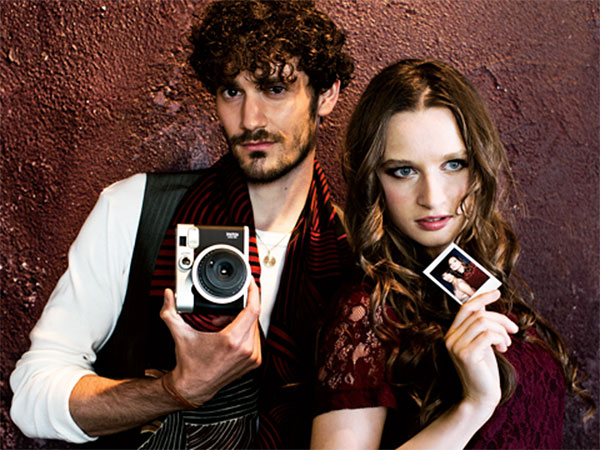
WB: And we've seen just in general, the market for film seems to be on the rise overall, which is an interesting kind of shift back.
SU: Yes, yes.
MO: So in Japan recently, you know the quick snaps, disposable [cameras], demand is increasing...
DE: Demand is increasing for disposable cameras now too?
MO: So that's also the young audience, young customers, they will use [it] because actually, for them it is kind of fun because they cannot see the result.
WB: Ah, so it's bringing back the wait in anticipation of it. Huh!
DE: That really is funny. I saw a video of the CEO of Fuji which I really thought it was kind of cool. He was talking about the film legacy and how Fuji was committed to maintaining that. Actually it was from a story about how when the film business declined, Fujifilm tried to figure out what can we use our technology for, and it turned out cosmetics was the big thing and so cosmetics is a huge profit item now for Fujifilm. But the CEO was saying even though film is very small -- it's like less than one percent of Fujifilm's revenue -- that Fujifilm is committed to maintaining that photographic history and that photographic base, which I thought was very neat.
MO: That is our big message from our CEO, Mr. Komori, is that he committed to maintaining [photography and photo film].
DE: Yeah, that's very neat. This is not really part of the interview at all, but it's something I've been impressed with. I read Mr. Komori's book -- the US public relations sent it to me and asked me to comment on it -- and it was interesting just to see how dynamic Fuji was able to be. And some of it is Mr. Komori himself. Everything was collapsing and declining and he was like the renegade, he was the guy that he wasn't just polite, he said, "We've gotta do something!" and they gave him control, and he found all these other things and so yeah, Fuji is doing pharmaceuticals and large flat-panel machinery manufacture and all the different things where they looked at "What are our basic technologies, what are our basic capabilities and what else could we do with that?" And yeah, so it's a great story and it's neat that he's committing to photography too. So very, very cool.

DE: We've pretty much covered our questions. There are some that we already touched on generally relative to the competition in the existing medium-format space. With Phase One and Hasselblad, they're selling much more expensive systems. And I'm wondering, how do you see the GFX competing at that level of the very high end of medium format? They have a very big share of that market. So we were curious about how you see the GFX. Right now, you're competing some in the full frame, but I don't know if it's competing against the [Pentax] 645Z or if it's really competing against Hasselblad and Phase One?
MO: Of course, we are really looking for the studio market. The studio photographers told us to [work with] equipment rental houses, so that's also one of the targets. That's the reason that in our gallery [of GFX] sample pictures, we have the portrait and studio-shooting samples. We are really expecting such photographers [to adopt the GFX].
DE: You're expecting that market.
MO: Yeah.
DE: One thing I noticed about the Phase One though is that Capture One, the software that ran on the computer to control the camera, it seemed very sophisticated. It could do a lot: You could manipulate the RAW file right there, and that struck me as being something that pro photographers would like.
WB: Unfortunately, Capture One probably won't be compatible with the GFX.
DE: Fuji can't make Phase One support a rival.
WB: But that kind of tethered shooting workflow, I think it's crucial for the studio photographer.
SU: Yes, yes. We have a solution with Adobe Lightroom raw conversion. We also have [our] Fujifilm original Tether Shooting Plug-in PRO with Lightroom, [which] we just released from November with the X-T2 and of course the GFX. Its functionality is quite good.
MO: So in the Adobe [system, it's] totally compatible. And for other software, [our] tethering software can send [images] to some particular folder.

DE: So you can be tethered and have it go to a particular folder...
WB: ...and then you can bring it into whatever...
MO: To other software.
DE: And then the Lightroom plug-in at that point.
SU: It's up to the third-party [whether they support our cameras], [and] the development schedule.
DE: I think that really does actually cover our questions. Very productive, very good answers!
SU, MO: Thank you.